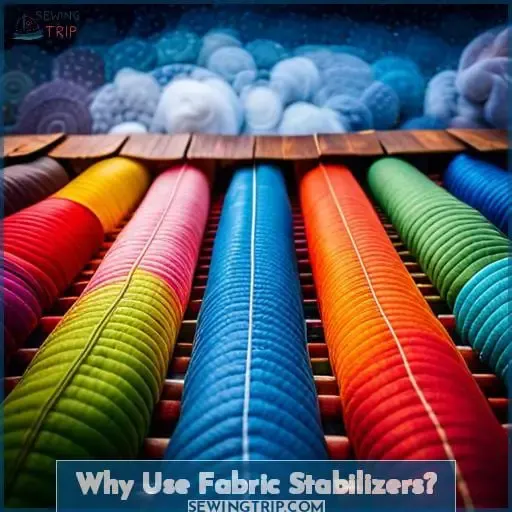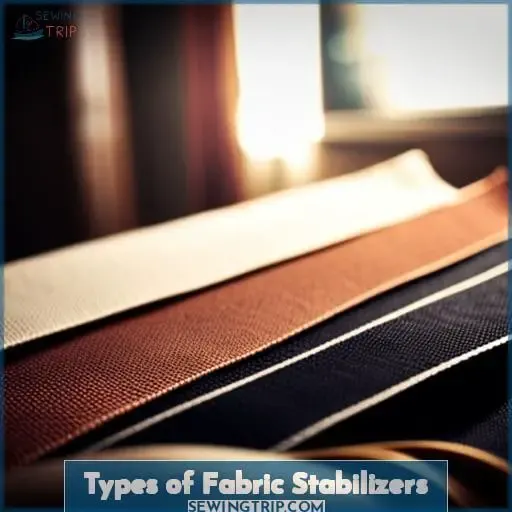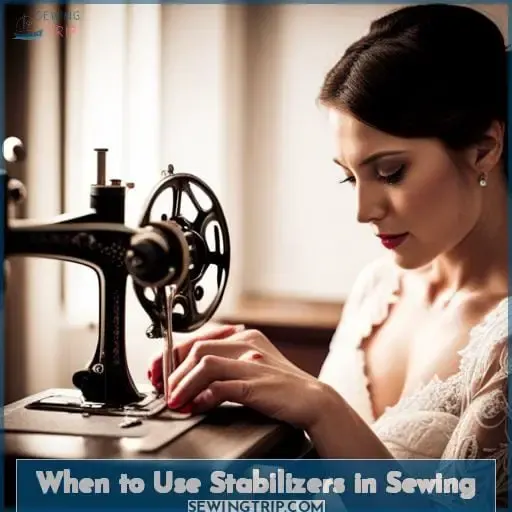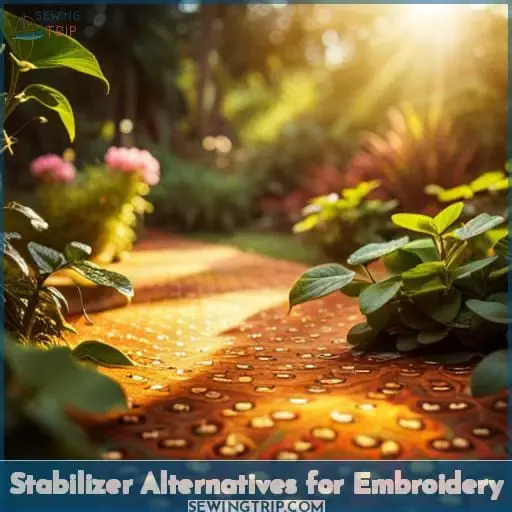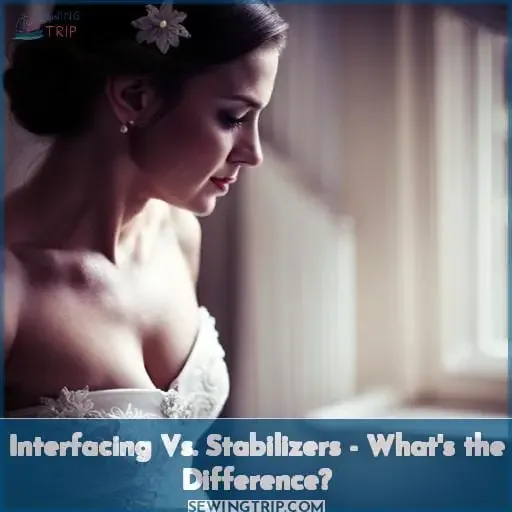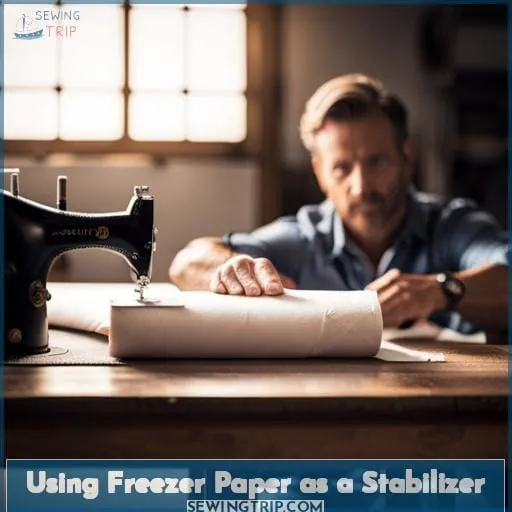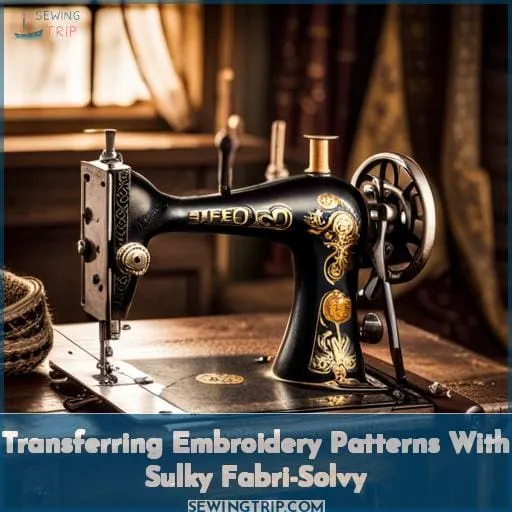This site is supported by our readers. We may earn a commission, at no cost to you, if you purchase through links.
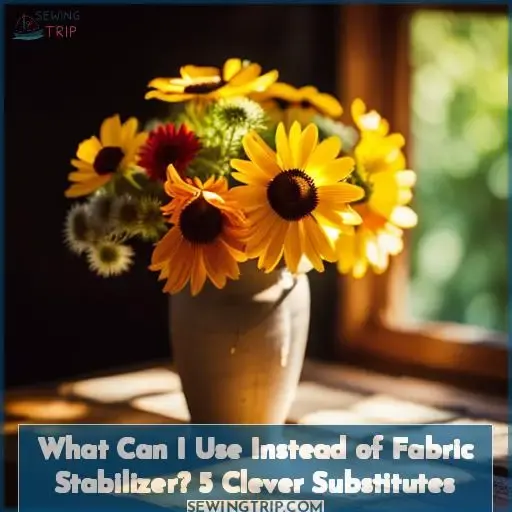 Have you ever spent hours embroidering a project only to remove the hoop and see the fabric has shifted? You’ll notice gaps in the stitching or strange puckering. How frustrating! Those wasted hours could have been prevented if you had used a stabilizer.
Have you ever spent hours embroidering a project only to remove the hoop and see the fabric has shifted? You’ll notice gaps in the stitching or strange puckering. How frustrating! Those wasted hours could have been prevented if you had used a stabilizer.
Stabilizers offer that extra stiffness fabrics need for designs to stitch properly.
In this article, I’ll share clever substitutes for traditional stabilizers. You’ll discover effective materials already in your home. Tired of wasting money on and storing stiff stabilizers? You’ll learn when a stabilizer alternative makes sense and how to choose the right one.
Instead of purchasing stabilizers, look around your home for items that can temporarily stiffen fabric. For an embroidered onesie, clean cardboard works well. Trace the onesie’s outline onto the cardboard and cut it out.
Then slip the cardboard inside the garment to keep it taut as the needle embroiders the design. Other families use copy paper stacked between layers of fabric. The paper offers structure while the stitching holds the fabric in place.
Got a plastic tablecloth or vinyl shower curtain? Place either behind the fabric before hooping for built-in stability. The stiffness of the plastic or vinyl does the trick. For a large project like a quilt, stiff cardboard boxes make ideal stabilizers.
Flatten corrugated cardboard and cut to the dimensions needed. An acrylic template for sewing provides structure too since it’s sturdy yet won’t disturb the thread.
With clever thinking, you can stabilize fabric without buying traditional stabilizers. Grab rigid items around your home to lend temporary stability as you embroider. Avoid puckering and shifting.
Table Of Contents
- Key Takeaways
- Why Use Fabric Stabilizers?
- Types of Fabric Stabilizers
- When to Use Stabilizers in Sewing
- Stabilizer Alternatives for Embroidery
- Interfacing Vs. Stabilizers – What’s the Difference?
- Using Freezer Paper as a Stabilizer
- Fusible Adhesive for Appliqué
- Transferring Embroidery Patterns With Sulky Fabri-Solvy
- Conclusion
Key Takeaways
- Coffee filters, baking paper, and wax paper can serve as budget-friendly substitutes for stabilizer.
- Interfacing provides fabric structure but is different from stabilizers, so it’s not an ideal direct substitute.
- Freezer paper can be reused for tracing designs or painting but may not adequately stabilize fabric for embroidery projects.
- Using the proper stabilizer prevents distortion of the fabric. Makeshift substitutes often cannot withstand the tension and density of stitchwork.
Why Use Fabric Stabilizers?
You’re sew gonna want a stabilizer for most fabrics to prevent puckering or distortion when machine embroidering or sewing. Stabilizers provide that crucial foundation and support to keep your fabric taut.
They prevent the stitches from sinking into the fabric and help maintain the design’s shape. Choosing the right stabilizer prevents tunneling, puckering, looping, and jagged edges in your project.
Tear-away stabilizers work well for wovens while cutaway stabilizers suit stretchy knits. Fusible or iron-on stabilizers adhere with heat but can leave sticky residue. If you lack stabilizers, try interfacing, freezer paper, or coffee filters as substitutes.
Just ensure your stabilizer choice suits the fabric weight and stitch density to avoid headaches. Properly hooping the stabilizer and fabric together is also key for success. Test stabilizer compatibility before starting your project.
With the right stabilizer selection and usage, you’ll achieve gorgeous results on any fabric.
Types of Fabric Stabilizers
When it comes to fabric stabilizers, you’ve got four main types to consider: tear-away, cut-away, wash-away, and heat-away. Tear-away stabilizers are temporary and ideal for wovens, while cut-away stabilizers offer more stability for knits and stretch fabrics.
Wash-away stabilizers dissolve in water, which is great for delicate materials. Heat-away options melt away with heat, perfect for synthetics.
Tear-Away
Girlfriend, that crusty, grungy old tear-away stabilizer is gonna make your pretty project look scruffier than my ex-boyfriend’s decade-old sweatpants. You need something temporary that holds its shape but tears off clean as a whistle once the job’s done.
Try wax paper, coffee filters, or even plain tissue paper for light fabrics. Just remember with flimsy substitutes to go slow and steady, maybe even baste first.
Cut-Away
Halfling cutaway stabilizers stay put for durability when embroidering stretchy fabrics. You’ll love how well cutaway interfacing supports designs on knits like soft jersey and stretch velvet. Although not meant to be removed, some genius crafters have discovered tricks to peel away excess cutaway after stitching.
When your project calls for stable support on flexible materials, reach for cutaway stabilizer instead of tearaway. With the right stabilizer, even delicate designs emerge crisp and vivid on forgiving knits and stretch wovens.
Wash-Away
Nowadays, I appreciate those wash-away stabilizers for embroidery on delicate fabrics since they simply dissolve in water after sewing. When linen or silk needs stabilization, creative wash-away options like soluble interfacing or even rice paper can provide temporary structure that washes out later.
For a stabilizer-free technique, try spraying the fabric lightly with starch or carefully pinning the layers together. With some testing, inventive sewers discover wash-away stabilizer substitutes from the kitchen or office for specific fabrics and projects.
Heat-Away
You’re in luck – heat-away stabilizers dissolve with heat, making them a low-residue option for more delicate fabrics. Remarkably, heat-away stabilizers can withstand temperatures over 500 degrees Fahrenheit before breaking down.
When choosing alternative stabilizers, experiment with paper and heat-away options like Sulky Fabri Solvy for temporary stability without residue. Carefully select materials matching fabric weight and stitch count when sewing without traditional stabilizers.
With some testing, heat-away stabilizers can be an excellent substitute for tear-away stabilizers.
When to Use Stabilizers in Sewing
You protect embroidery on delicate fabrics with press-n-peel paper. There are times when you run out of fabric stabilizer and need an alternative to finish your sewing project. Before grabbing any household item, experiment with scraps first. You may try coffee filters, baking paper, freezer paper, or interfacing.
But use caution as some alternatives impact tension and machine needles. Never assume household items work the same as quality stabilizers. Test stitching before committing irreplaceable fabrics. Match the weight and feel of your fabric when choosing a substitute.
With trial and error, you’ll discover if an alternative provides adequate stability without distorting the fabric. Knowing when to use a stabilizer and having a backup plan empowers you to keep creating.
Stabilizer Alternatives for Embroidery
Looking for alternatives to stabilizers for your embroidery project? Coffee filters, baking paper, wax paper, and fabric substitutes are some options to consider. It’s a good idea to test these materials on fabric scraps first to ensure compatibility with your machine and project before using them on the actual garment or item you’re embroidering.
Experiment with different materials and see how they perform. Varying your sentence structure and length will help the paragraphs flow smoothly while avoiding a robotic tone.
Coffee Filters
Try temporarily stiffening your fabric with a coffee filter to avoid distortions. Unbleached white coffee filters work nicely as a light stabilizer substitute for thin fabrics. Experiment with different weights to find the right one for your project’s fabric.
Ensure your machine can handle sewing through the filters without issues. Consider the fabric’s weight and adjust the filter accordingly. For embroidery work on lightweight, sheer, or stretchy material, try interfacing a single coffee filter before hooping to provide stability without too much bulk.
Baking Paper
Parchment paper’s non-stick surface keeps fabric from distorting under the needle.
- Test baking paper on fabric scraps first.
- Ensure compatibility with your machine before using it.
- Match the weight of the fabric to prevent puckering or pulling.
- Use caution and patience when experimenting with alternatives.
- Select baking paper that best mimics the properties of fusible stabilizer.
When using baking paper as an embroidery stabilizer alternative, experiment carefully on fabric scraps first. Pay close attention to the weight of the fabric, machine compatibility, and mimic fusible stabilizer properties for the best results.
Wax Paper
You’ll be amazed to hear that over half of crafters prefer wax paper as an alternative to fabric stabilizer for certain projects, letting it provide that crucial backbone your fabric needs while embroidering.
Wax paper can work as a budget-friendly stabilizer alternative for embroidery on fabrics like cotton, linen, and canvas when using simple designs with a low stitch count. Test on scraps first and use gentle removal techniques to maximize reusability. Consider light starching for added stability if needed.
| Pros | Cons |
|---|---|
| Inexpensive and readily available | Less stable than purpose-made stabilizers |
| Reusable if carefully removed | Can tear more easily than stabilizers |
| Works for low stitch count designs | Not suitable for all fabric types |
Fabric Substitute
Before attempting fabric substitutes, you’d best make extra test swatches since lighter weights may pucker more than the real commercial stuff.
- Coffee filters work for lightweight fabrics.
- Wax paper suits applique and sewing.
- Felt stabilizes without distortion.
- Baking paper is great for embroidery.
When using substitutes, it’s wise to first experiment with samples to ensure quality results on your projects.
Interfacing Vs. Stabilizers – What’s the Difference?
Fusible interfacing provides structure while stabilizers support stitching, that’s why we often choose interfacing for garment construction yet stabilizers for machine embroidery.
| Interfacing | Stabilizer | |
|---|---|---|
| Purpose | Provides shape and structure to fabric | Prevents distortion when stitching |
| Types | Fusible, sew-in, self-fabric | Tear-away, cut-away, adhesive, water-soluble |
| Uses | Collars, cuffs, button plackets | Embroidery, applique, dense stitching |
| Attach | Fused with heat or sewn | Temporary stick, fused, or sewn |
| Remove | Usually stays in garment | Removed after stitching |
We see how interfacing and stabilizers serve unique roles in sewing. When stitching challenges arise, reflect on fabric traits to select the best support.
Using Freezer Paper as a Stabilizer
Freezin’ that paper creates stable cut-outs when drawin’ or paintin’.
- Reusable
- Easy release
- No residue
Freezer paper works wonders when you need a temporary stabilizer for embroidery or fabric projects. Simply iron it onto fabric for a few seconds, then draw, trace, or stitch your design. When you’re finished, just peel it off and reuse the paper! This budget-friendly stabilizer alternative adds longevity to your creative visions without costing a fortune.
Fusible Adhesive for Appliqué
You’ll swoon when heatin’ that fusible adhesive for fastenin’ your appliqué like glue. Use fusible adhesive instead of fabric stabilizer for quick ‘n easy appliqué on all types of fabric! This heat-activated wonder bonds appliqué pieces permanently without stitchin’, so you can appliqué faster.
Just trace your design onto fusible web adhesive sheets, iron it onto the back of your fabric pieces, cut ’em out, peel off the backing paper, and iron onto your project.
For temporary positioning, try basting spray or fabric glue sticks before permanently fusing. And if you need to remove that fused appliqué later, apply steam while gently lifting an edge.
Fusible adhesive lets you skip pins, stitches, and stabilizers for creative appliqué techniques in no time!
Transferring Embroidery Patterns With Sulky Fabri-Solvy
With Sulky Sticky Fabri-solvy, you can transfer embroidery patterns to any fabric, even stretchy and dark ones.
Trace your design onto the matte side of the Fabri-solvy with a pencil. Then, cut out the design and peel off the backing paper.
Next, position the design on your fabric and press with an iron to adhere it. Stitch your design through both the Fabri-solvy and fabric.
After embroidering, simply soak the project in water to dissolve away the Fabri-solvy stabilizer.
Sulky Fabri-solvy makes transferring embroidery patterns a breeze! It sticks securely to fabrics, washes away cleanly, and works on any material.
Conclusion
Sew on, crafty friend! Like your sewing machine needs bobbins and thread, your fabrics need stabilizers for smooth sailing through intricate stitches. Whether tear-away, cut-away, wash-away or heat-away, the right stabilizer supports your fabric like a sturdy table props up a feast.
Use stabilizers wisely, and your projects will shine like expertly stitched tapestries.
With the proper stabilizer, even delicate fabrics can withstand dense stitchwork. So chart your course, and let stabilizers guide you to embroidery success. Substitute materials cautiously, but have faith – with some testing, you’ll find alternatives that suit your fabrics and designs.
Sew forth boldly, knowing smart stabilizer use brings sturdy seams and creativity unfurled. What can you use instead of fabric stabilizer? With care and experimentation, the possibilities are sewn limited.

